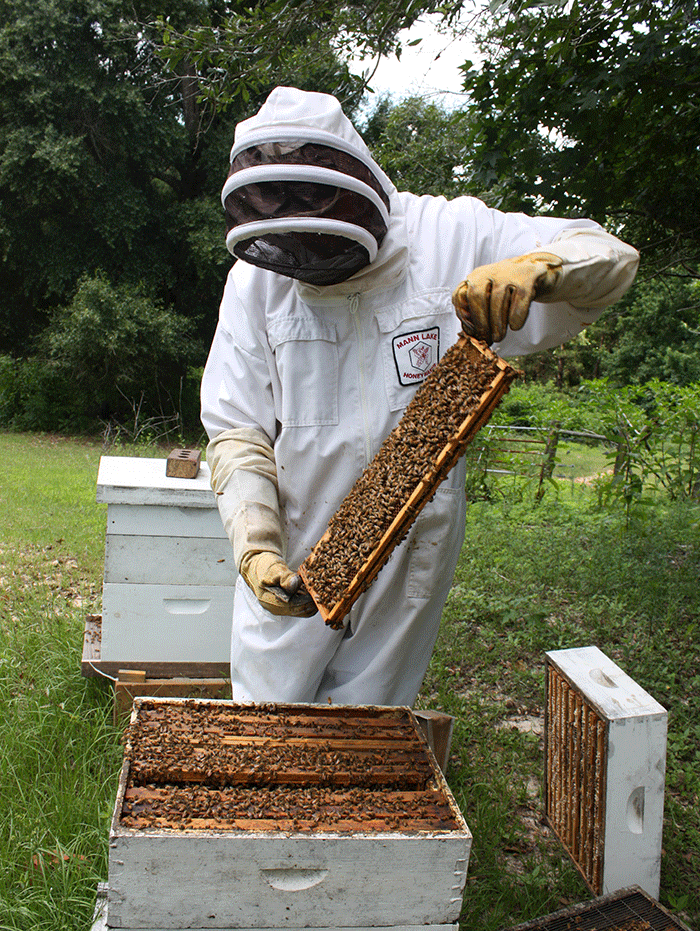
By Lori Quiller
Even after more than 20 years as a beekeeper, Gerry Whitaker of New Brockton takes great care when approaching his honey hives. After all, he’s allergic to them.
“Got stung once right through my glove,” he says as he splayed out his hand to show his rough-hewed farm work glove. “You wouldn’t think a little honeybee could sting through a cowhide glove, but that one did. And my eye was pretty swollen before I could get back to the shop.”
He wears protection from head to toe when working with the hives. The familiar white suits that beekeepers wear are durable but hot, topped off with a caged-in helmet that zips onto the neckline of the suit, and the beekeeper is ready to check on the health of his hives.
Whitaker’s white boxes may look innocent enough dotting the landscape of his farmland in rural Coffee County, but they each contain between 30,000 and 60,000 of nature’s little honey makers.
Although the boxes appear to be cabinets with drawers that slide out, they actually come apart from the top, and that’s where Whitaker begins his inspection by easing the lid off the top and being careful not to stand in front of the hive when he does.
“I wouldn’t stand in front of the box when I lift the lid,” he says. “That hole at the bottom is where they come and go from. They might decide to go in a minute.”
This gentle man takes all the care in the world as he lifts the lid of the hive and slides a rack of bees from its resting place. He was correct, too. The bees in the bottom of the hive got the signal that something was amiss…and the escape hatch was filled with angry bees in a split second ready to protect their home, queen and their hard work for the season – honey.
As he raised the rack and the bees slid away, the sealed comb became visible. Each tiny octagon was filled with the golden honey and capped with wax. This is a healthy hive, and Whitaker is taking great care to keep it that way.
Bees are an important link in the food chain
“People naturally think about honey when they think about honeybees,” Whitaker says, “but honeybees are so much more important to our food chain than most people realize. Without them and the work they do, the food we eat wouldn’t make it to our tables. Now that’s even in danger.”
Today’s families and restaurant owners are more conscious about farm-to-table food and keeping produce as fresh and as organic as possible for purchase. However, it all starts with a single bloom fertilized with the pollen scattered on the legs of the humble honeybee.
“Pollination is responsible for $15 billion a year in the U.S. when it comes to agricultural production. There is not a fruit that doesn’t require pollination. A healthy hive has between 30,000 and 60,000 bees. To pollinate one acre of apple trees, you’ll need one hive of healthy bees. When we pollinate a watermelon field, we take 3-4 hives for about 7 acres, and we don’t get any honey back from that. The issue there is that we need the pollen. The important part is the pollination, but everyone focuses on the honey,” Whitaker says.
Whitaker offers a cautionary note for consumers trying to eat primarily organic produce. If you see a bottle of honey with a certified organic or organic label attached to it, be suspicious.
“It’s difficult to say that this honey is from this crop because the bees can travel up to 2.5 miles away from the hive to forage. I may not use pesticides on my fields, but I don’t know what’s being used on anyone else’s fields where those bees have been. There’s no way to certify honey as organic even though it is a purely natural food,” he says.
While honeybees are the best pollinators for the produce that we eat, they are under attack by a mysterious disease called Colony Collapse Disorder. The disease, which remains a mystery, is being investigated at the state and federal levels. The Agricultural Research Service, the USDA’s internal research agency, is leading several efforts into possible CCD causes of the disease that has proven to be an international phenomenon.
According to Whitaker, who is also president of the Southeast Alabama Beekeepers Association, he lost about 70 percent of his bee colonies last October due to Colony Collapse Disorder and the national loss is projected to be 50-90 percent for this year.
“Because we can’t predict CCD, we inspect the hives closely. There are signs of an unhealthy hive, so close inspection is very important,” Whitaker says.
Beekeeping is a process and some look at it as farming as with cows or pigs. With farming comes education, and the Southeast Alabama Beekeepers Association and the Alabama Beekeepers Association provide educational programs for those interested in learning how to keep honeybees and harvest the honey during the two harvesting seasons. There are levels of education from apprentice, journeyman, master, to master craftsman beekeeper with the master beekeeper program taking four years to complete.
Those just starting out are expected to register their honeybee colonies with the Alabama Department of Agriculture, pursuant to state law, and state societies can assist with the registration. To contact the associations for more information, visit www.alabamabeekeepers.com, www.southeastalabamabeekeepers.com, and Whitaker’s company, Beeginnings, at www.beginnings.net.





